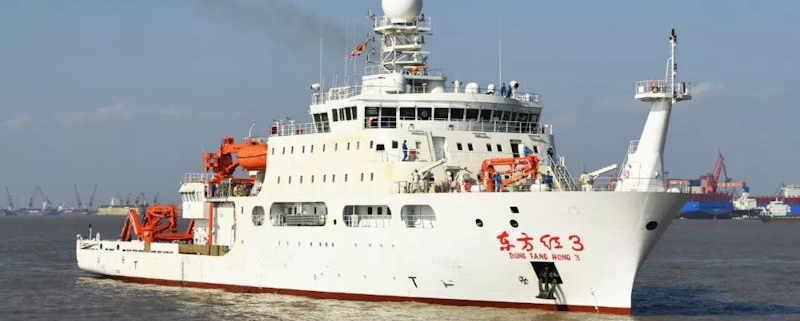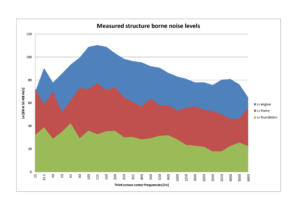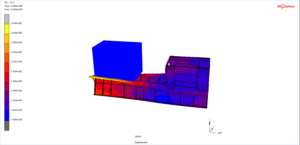The next level in silence for research vessels
Rubber Design delivers Dong Fang Hong 3
Scientific marine measurements require a minimum of underwater radiated noise. The highest
international standard for underwater noise control is the Silent-R certification, issued by DNV GL,
the Norwegian international certification body. The ‘Dong Fang Hong 3’ built by Shanghai-based
Jiangnan Shipyard (Group) Co., Ltd is the first Chinese research vessel (and the world’s fourth) to
have obtained this Silent-R certificate.
Rubber Design delivered the bespoke resilient mounting systems for ‘Dong Fang Hong 3’. Rubber
Design reached a new level in silence, based on the experience with other research vessels.
Working on more and more silence for research vessels
Rubber Design is well known with the standards and technology to minimize underwater radiated
noise from research vessels. The ICES 209 standard provides guidelines for this. Prior to the ‘Dong
Fang Hong 3’, Rubber Design already delivered mounting systems to the a few research vessels that
met this high international standard. The first one was the ‘Investigator’, operated by CSIRO, the
Commonwealth Scientific and Industrial Research Organisation. This is their state-of-the-art marine
research vessel. It supports Australia’s atmospheric, oceanographic, biological and geosciences
research from the tropical north to the Antarctic ice-edge. This vessel is equipped with MaK 9M25
engines. We achieved all of the acoustic requirements including airborne noise, vibrational
behaviour, and most importantly radiated underwater noise.
Typical example of measured structure born noise levels.
Two more silent research vessels
Rubber Design also supplied the resilient mounting system for the Norwegian fishery and
oceanographic research ship ‘Dr. Friedtjof Nansen’. It is owned by NORAD, the Norwegian Agency
for Development Cooperation, and will mainly operate in tropic and sub-tropic areas in developing
countries. This ship features MaK 9M25 and 6M20 generatorsets with a similar double-resilient
mounting design. And then there is the ‘Sir David Attenborough’ research vessel. This was built at
Cammell Laird in the UK and is now operated by BAS, the British Antarctic Survey. The vessel is
fitted with Bergen B33:45L6A and B33:45L9A engines. Rubber Design successfully provided the
resilient mounting systems for the mentioned diesel generatorsets and its exhaust equipment.
Next level: ‘Dong Fang Hong 3’
Our track record in delivering bespoke technology for noise reduction led to the ‘Dong Fang Hong 3’.
This research vessel which will be used by the Ocean University of China for a variety of
oceanographic research. Due to the nature of working in natural environments, the critical challenge
to a diesel engine is the ability to run at full power while emitting the least noise and vibration as
possible. This should be the case both within the vessel and into the marine environment. Limiting
the levels of noise and vibration pollution provides minimal disruption to marine life and to the
scientific measuring equipment on board. At Rubber Design, our experts develop solutions that
isolate the source of disturbance reducing marine noise and vibration pollution for an array of oceangoing
projects. This is a true team effort. In this case, our specialists closely worked with specialists
from Caterpillar Marine in Kiel, Germany. We joined forces to develop the unique double-resilient
mounting solution for the MaK 9M25C and 6M20C generatorsets.
Rubber Design also successfully delivered the exhaust suspension system to the shipyard. Working
from plans supplied by the shipyard, the expertise of Rubber Design meant they were able to
provide a bespoke system built precisely to design specifications.
For research vessels in general, Rubber Design is well experienced to design a suitable resilient
mounting system. Most vessels are equipped with a so-to-say double elastic mounting system.
Rubber Design provides not only the calculations for such resilient mounting system and the design
for the intermediate frame, but can serve also with measurements.
Your project tailor made
Rubber Vessels is always willing to adapt to clients wishes and requirements. You may benefit from
the next services:
- Full Report on the static and dynamic behaviour of the double elastic mounted installation.
This includes 12 degrees of freedom calculation for determination of the optimum mounting
types and rubber hardness and the 12 natural frequencies of the set; - Check-up and review of the subframe for its natural frequencies and modes with FEA
software. This could include a possible re-design and engineering / construction of the
existing base frame in order to get the best possible solution; - Calculation of the subframe for its mobility with FEA software. This engineering work can be
performed after the check-up and review of the subframe for its natural frequencies and
modes; - Prediction of SBN (Structure Born Noise) isolation, taking into consideration the transfer
function of the mountings, which are measured in our in-house R&D test laboratory; - Vibration measurements. These measurements can include
o The measurements of foundation impedance in accordance to ISO 7626-5;
o SBN Measurements in accordance to ISO 13332
o Vibration measurements in accordance to ISO 8528-9 or 10816-6;
o FRF measurements of the common base frame based on a ‘roving’ sensor and
impact hammer to determine natural frequencies and corresponding ‘mode shapes’;
o Operational deflection shape (ODS) measurements of the complete genset.
Rubber Design is proud to have been involved with the engineering and delivery of such projects and
to play a part in the increased scientific research presence.









